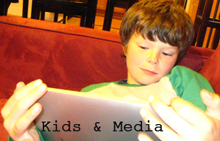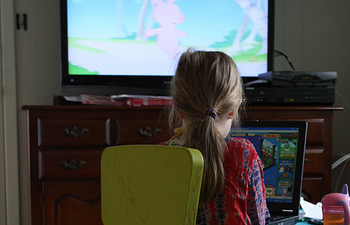
This week, MediaShift will be running a special series on navigating the relationships between kids and media. Stay tuned all week as we explore topics like this one.
When it comes to videogames and apps, what’s a parent to do? On one hand, we’re bombarded with messages about the perils of letting kids play with computer games and gadgets. On the other, we’re seduced by games and apps marketed to us as “educational.”
It’s a tricky line to navigate. The spectrum of kids’ apps ranges from “baking” cupcakes to crushing war demons. Most of them have some educational aspect — at the very least kids learn what ingredients are used in cupcake baking, and the physics of launching Angry Birds at just the right angle to kill the piggies. That’s learning, isn’t it?
Therein lie the vague boundaries. Not all games are educational, and not all are shallow forms of entertainment. Many are marketed as educational tools, but in fact, most have some elements of both. The trick is to figure out what we want kids to learn and to experience. To clump them all into one category is to miss out on a huge treasure trove of learning opportunities. Real learning apps have a set of criteria that qualifies them as educational, so rather than writing them all off as a waste of time, parents can figure out what their kids are exposed to.
Engagement and Learning
“We don’t ever want to separate engagement from the purposes of learning,” said Daniel Edelson, Executive Director and Vice President of Education and Children’s Programs at the National Geographic Society at a cyberlearning conference this spring. “When you’re engaged with activities that have learning goals, you can connect the dots between engagement and learning. If you use engagement in its broadest possible sense when people are paying attention because of bright lights and activity, then you don’t find that connection.”
Enter the parent. A young child is not necessarily going to figure out if she’s learning or having fun. And in the best cases, that line is blurred without the child even knowing it. She’s collecting information about bugs and plantlife with apps like Project NOAH. She’s creating original stories — complete with exposition and denouement and background music — with digital storytelling apps like Toontastic.
So should parents feel guilty allowing their kids to play games on mobile gadgets?
Simply put: “No,” says Dr. Michael Levine of the Joan Ganz Cooney Center, which recently released a study called Learning: Is There an App For That. “Kids see their parents using mobile phones all the time. It’s only natural for them to want to use them too. And from the data in our study it looks like many parents are letting their children use them responsibly – with restrictions and in moderation. We recommend a balanced media diet that consists of content that is fun, educational, and doesn’t take up too much time in a given day.”
Tools to Create Content
That said, Levine cautioned parents to stay vigilant about screen time. “We would be quite concerned if young children, especially pre-schoolers, began to dramatically increase their mobile screen time,” he said.
A screen is not just a screen, though. The one-way interaction between TV and the couch potato is far different than an absorbing Scrabble play-off with a friend on a mobile phone.
“Nobody’s saying, ‘Give your kid a Gameboy, so he can be quiet and go sit in the corner,” said Andy Russell, co-creator of Toontastic at a digital media and learning conference. “We’re giving them tools to actually help them create content. The new devices allow us to do new things that we haven’t ever been able to do. But the world of ‘edutainment’ has dug us into a hole where most people think games only create a solitary experience.”
In fact, many apps invite multiple players, social interaction with peers, and a call to go outdoors, either with specific instructions or with the child’s own imagination. When my daughter and her friend were deciding how to spend their Saturday afternoon last week, their indoor play turned into an outdoor movie that they scripted, and that I filmed and edited for them with my iPhone.
“Most parents don’t understand the need for their participation,” said Dr. Gwenn O’Keeffe, a pediatrician who says she specializes in children’s media use. “It’s a small population who gets it.”
Russell says game designers should also take responsibility in guiding parents on how to interact with the games and their kids. “The failure is not the technology, but how we communicate to parents,” he said.
BEYOND SCREENS
Regardless of how educational or engaging a screen can be, O’Keeffe says emotional connections are lost without face-to-face contact. “If they’re looking at a screen, they can’t see the emotional response,” said O’Keeffe, who believes screens should be kept out of the hands of kids under 5 years old. “It’s about empathy and they’re having trouble learning that. Do you really need to turn on the DVD in the car? Do kids really need the Gameboy in the grocery store? We all have to use the screen as babysitter sometimes. But to always use a screen that often is a problem.”
But gaming advocates argue that social connections are built into most games. That sharing tactics and strategies help cement the learning experience — and connect players to each other in ways that haven’t been done before.
As researchers dig deeper into the ramifications of games and apps on young minds, parents will have to navigate the gray areas between absent-minded parenting and the smart use of technology.
Photo of boy with iPad by Mark Glaser.
Photo of girl with an iPad by Alec Couros via Flickr.
Read more about how technology wires the learning brain and suprising truths about videogames. Read more stories in the Kids & Media series on MediaShift.
Tina Barseghian is the editor of KQED’s MindShift, an NPR website about the future of education. In the past, she’s worked as the executive editor of Edutopia, a magazine published by the George Lucas Education Foundation, as well as an editor at O’Reilly Media and CMP Media. She lives in the San Francisco Bay Area.
This post originally appeared on KQED’s MindShift, which explores the future of learning, covering cultural and tech trends and innovations in education. Follow MindShift on Twitter @mindshiftKQED and on Facebook.

